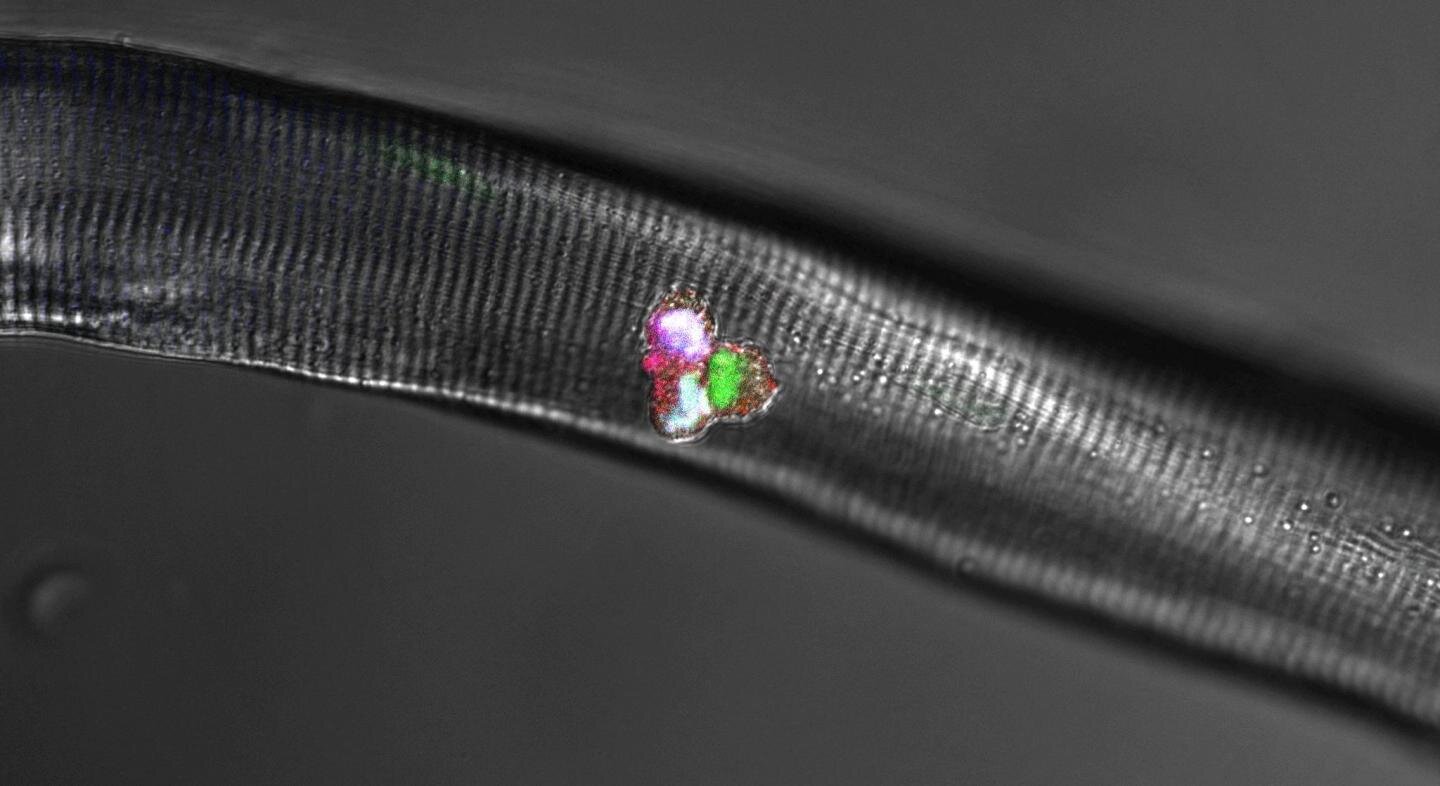
Immunofluorescence analysis of a group of proliferating stem cells associated with a muscle fiber (gray). The stem cells produce Dll1 (red) and MyoD (green). Two of the cells produce MyoG (blue): they distinguish each other to form a new muscle cell. Note that the cover looks blue, green and red white. Credit: Birchmeier Lab, MDC
As a muscle grows because the owner is still growing or starting to exercise regularly, some of the stem cells in this muscle develop into new muscle cells. The same thing happens when an injured muscle heals. At the same time, however, the muscle stem cells have to produce further stem cells – that is, to renew themselves – as their supply would otherwise be depleted quickly. This requires the cells involved in muscle growth to communicate with each other.
Muscle growth is regulated by the Notch signaling pathway
Two years ago, a team of researchers led by Professor Carmen Birchmeier, head of the developmental biology / signal transduction laboratory at the Berlin Max Delbrück Center for Molecular Medicine at the Helmholtz Association (MDC), showed that stem cell development in muscle cells is regulated by using two proteins, Hes1 and MyoD, which are produced in an oscillating way in the progenitor cells – ie there are periodic fluctuations in the number of cells produced.
Both proteins are involved in the Notch signaling pathway, a widespread mechanism by which cells respond to external stimuli and communicate with other cells. The signaling pathway is named after the receptor “Notch” on which the ligand “Delta”, a cell surface protein, attaches.
A third protein, Delta-like1, plays a crucial role
“In our present study, we have provided unequivocal evidence that oscillation in muscle tissue is not just some foreign phenomenon of the cells involved, but that these rhythmic fluctuations in gene expression are actually crucial for the transformation of stem cells into muscle cells in a balanced and controlled way, ‘says Birchmeier.
Together with researchers from Japan and France, Birchmeier and four other scientists at the MDC also discovered the crucial role of a third protein that, together with Hes1 and MyoD, forms a dynamic network within the cells. As the team reports in the journal Nature communication, this protein is the Notch ligand Delta-like1, or Dll1 for short. “It is produced in a periodically varying manner in activated muscle stem cells, with the oscillation period lasting two to three hours,” explains Birchmeier, adding: “When a portion of the stem cells express more Dll1, the amount in the other cells correspondingly lower. This rhythmic signal determines whether a stem cell becomes a new stem cell or develops into a muscle cell. ‘
The Hes1 protein indicates the rate in the stem cells
In their experiments with isolated stem cells, individual muscle fibers, and mice, Birchmeier and her team further investigated how the Hes1 and MyoD proteins are involved in muscle growth. “Simply put, Hes1 acts as the oscillating pacemaker, while MyoD increases the Dll1 expression,” says dr. Ines Lahmann, a scientist in Birchmeier’s laboratory and a lead author of the study with Yao Zhang from the same team. “These findings have been shown not only in our experimental analyzes, but also in the mathematical models created by Professor Jana Wolf and Dr. Katharina Baum at the MDC,” says Birchmeier.
Experiments with mutant mice provided conclusive evidence
Using unmodified mice, the researchers found the most important evidence that Dll1 oscillation plays a critical role in regulating the transformation of stem cells into muscle cells. “In these animals, a specific mutation in the Dll1 gene causes protein production with a delay of a few minutes,” explains Birchmeier. “It disrupts the oscillating production of Dll1 in cell communities, but does not alter the total amount of ligand.”
“Nevertheless, the mutation has serious effects on the stem cells, which drives them to differentiate prematurely into muscle cells and fibers,” reports Zhang, who performed much of the experiments. As a result, he says, the stem cells were depleted very quickly, which, among other things, led to an injured muscle in the mice’s hind legs regenerating poorly and remaining smaller than before the injury. “Clearly, this minimal genetic change succeeds in disrupting the successful communication – in the form of oscillation – between stem cells,” says Zhang.
This knowledge can lead to better treatments for muscle diseases
“Only when Dll1 binds to the Notch receptor in an oscillating manner and thus periodically initiates the signal cascade in the stem cells, is there a good balance between self-renewal and differentiation in the cells,” Birchmeier concludes. The MDC researcher hopes that a better understanding of muscle regeneration and growth can one day help create more effective treatments for muscle injuries and diseases.
Oscillation in muscle tissue
Yao Zhang et al, Delta-like oscillations1 regulate the balance between differentiation and maintenance of muscle stem cells, Nature communication (2021). DOI: 10.1038 / s41467-021-21631-4
Provided by Max Delbrück Center for Molecular Medicine
Quotation: The Key to Proper Muscle Growth (2021, February 26), Retrieved February 27, 2021 from https://medicalxpress.com/news/2021-02-key-proper-muscle-growth.html
This document is subject to copyright. Except for any fair trade for the purpose of private study or research, no portion may be reproduced without the written permission. The content is provided for informational purposes only.
